Yijia Wang
Generative Semantic Coding for Ultra-Low Bitrate Visual Communication and Analysis
Oct 31, 2025Abstract:We consider the problem of ultra-low bit rate visual communication for remote vision analysis, human interactions and control in challenging scenarios with very low communication bandwidth, such as deep space exploration, battlefield intelligence, and robot navigation in complex environments. In this paper, we ask the following important question: can we accurately reconstruct the visual scene using only a very small portion of the bit rate in existing coding methods while not sacrificing the accuracy of vision analysis and performance of human interactions? Existing text-to-image generation models offer a new approach for ultra-low bitrate image description. However, they can only achieve a semantic-level approximation of the visual scene, which is far insufficient for the purpose of visual communication and remote vision analysis and human interactions. To address this important issue, we propose to seamlessly integrate image generation with deep image compression, using joint text and coding latent to guide the rectified flow models for precise generation of the visual scene. The semantic text description and coding latent are both encoded and transmitted to the decoder at a very small bit rate. Experimental results demonstrate that our method can achieve the same image reconstruction quality and vision analysis accuracy as existing methods while using much less bandwidth. The code will be released upon paper acceptance.
Understanding the Implicit User Intention via Reasoning with Large Language Model for Image Editing
Oct 31, 2025Abstract:Existing image editing methods can handle simple editing instructions very well. To deal with complex editing instructions, they often need to jointly fine-tune the large language models (LLMs) and diffusion models (DMs), which involves very high computational complexity and training cost. To address this issue, we propose a new method, called \textbf{C}omplex \textbf{I}mage \textbf{E}diting via \textbf{L}LM \textbf{R}easoning (CIELR), which converts a complex user instruction into a set of simple and explicit editing actions, eliminating the need for jointly fine-tuning the large language models and diffusion models. Specifically, we first construct a structured semantic representation of the input image using foundation models. Then, we introduce an iterative update mechanism that can progressively refine this representation, obtaining a fine-grained visual representation of the image scene. This allows us to perform complex and flexible image editing tasks. Extensive experiments on the SmartEdit Reasoning Scenario Set show that our method surpasses the previous state-of-the-art by 9.955 dB in PSNR, indicating its superior preservation of regions that should remain consistent. Due to the limited number of samples of public datasets of complex image editing with reasoning, we construct a benchmark named CIEBench, containing 86 image samples, together with a metric specifically for reasoning-based image editing. CIELR also outperforms previous methods on this benchmark. The code and dataset are available at \href{https://github.com/Jia-shao/Reasoning-Editing}{https://github.com/Jia-shao/Reasoning-Editing}.
Runge-Kutta Approximation and Decoupled Attention for Rectified Flow Inversion and Semantic Editing
Sep 16, 2025Abstract:Rectified flow (RF) models have recently demonstrated superior generative performance compared to DDIM-based diffusion models. However, in real-world applications, they suffer from two major challenges: (1) low inversion accuracy that hinders the consistency with the source image, and (2) entangled multimodal attention in diffusion transformers, which hinders precise attention control. To address the first challenge, we propose an efficient high-order inversion method for rectified flow models based on the Runge-Kutta solver of differential equations. To tackle the second challenge, we introduce Decoupled Diffusion Transformer Attention (DDTA), a novel mechanism that disentangles text and image attention inside the multimodal diffusion transformers, enabling more precise semantic control. Extensive experiments on image reconstruction and text-guided editing tasks demonstrate that our method achieves state-of-the-art performance in terms of fidelity and editability. Code is available at https://github.com/wmchen/RKSovler_DDTA.
CVBench: Evaluating Cross-Video Synergies for Complex Multimodal Understanding and Reasoning
Aug 28, 2025Abstract:While multimodal large language models (MLLMs) exhibit strong performance on single-video tasks (e.g., video question answering), their ability across multiple videos remains critically underexplored. However, this capability is essential for real-world applications, including multi-camera surveillance and cross-video procedural learning. To bridge this gap, we present CVBench, the first comprehensive benchmark designed to assess cross-video relational reasoning rigorously. CVBench comprises 1,000 question-answer pairs spanning three hierarchical tiers: cross-video object association (identifying shared entities), cross-video event association (linking temporal or causal event chains), and cross-video complex reasoning (integrating commonsense and domain knowledge). Built from five domain-diverse video clusters (e.g., sports, life records), the benchmark challenges models to synthesise information across dynamic visual contexts. Extensive evaluation of 10+ leading MLLMs (including GPT-4o, Gemini-2.0-flash, Qwen2.5-VL) under zero-shot or chain-of-thought prompting paradigms. Key findings reveal stark performance gaps: even top models, such as GPT-4o, achieve only 60% accuracy on causal reasoning tasks, compared to the 91% accuracy of human performance. Crucially, our analysis reveals fundamental bottlenecks inherent in current MLLM architectures, notably deficient inter-video context retention and poor disambiguation of overlapping entities. CVBench establishes a rigorous framework for diagnosing and advancing multi-video reasoning, offering architectural insights for next-generation MLLMs. The data and evaluation code are available at https://github.com/Hokhim2/CVBench.
A multi-source data power load forecasting method using attention mechanism-based parallel cnn-gru
Sep 26, 2024



Abstract:Accurate power load forecasting is crucial for improving energy efficiency and ensuring power supply quality. Considering the power load forecasting problem involves not only dynamic factors like historical load variations but also static factors such as climate conditions that remain constant over specific periods. From the model-agnostic perspective, this paper proposes a parallel structure network to extract important information from both dynamic and static data. Firstly, based on complexity learning theory, it is demonstrated that models integrated through parallel structures exhibit superior generalization abilities compared to individual base learners. Additionally, the higher the independence between base learners, the stronger the generalization ability of the parallel structure model. This suggests that the structure of machine learning models inherently contains significant information. Building on this theoretical foundation, a parallel convolutional neural network (CNN)-gate recurrent unit (GRU) attention model (PCGA) is employed to address the power load forecasting issue, aiming to effectively integrate the influences of dynamic and static features. The CNN module is responsible for capturing spatial characteristics from static data, while the GRU module captures long-term dependencies in dynamic time series data. The attention layer is designed to focus on key information from the spatial-temporal features extracted by the parallel CNN-GRU. To substantiate the advantages of the parallel structure model in extracting and integrating multi-source information, a series of experiments are conducted.
Regularized Contrastive Partial Multi-view Outlier Detection
Aug 02, 2024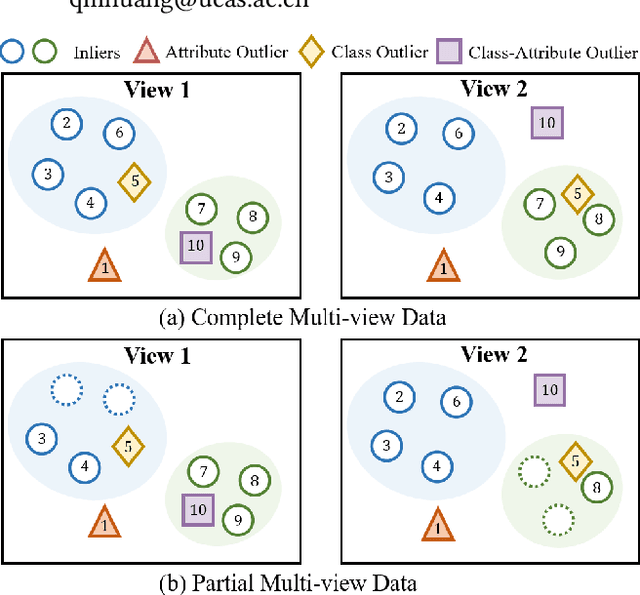

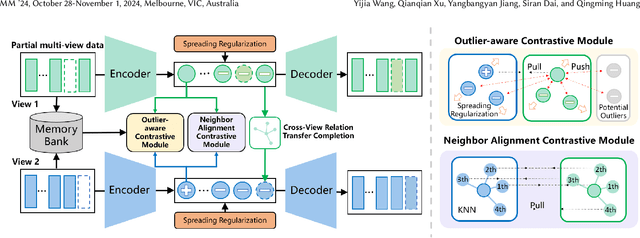

Abstract:In recent years, multi-view outlier detection (MVOD) methods have advanced significantly, aiming to identify outliers within multi-view datasets. A key point is to better detect class outliers and class-attribute outliers, which only exist in multi-view data. However, existing methods either is not able to reduce the impact of outliers when learning view-consistent information, or struggle in cases with varying neighborhood structures. Moreover, most of them do not apply to partial multi-view data in real-world scenarios. To overcome these drawbacks, we propose a novel method named Regularized Contrastive Partial Multi-view Outlier Detection (RCPMOD). In this framework, we utilize contrastive learning to learn view-consistent information and distinguish outliers by the degree of consistency. Specifically, we propose (1) An outlier-aware contrastive loss with a potential outlier memory bank to eliminate their bias motivated by a theoretical analysis. (2) A neighbor alignment contrastive loss to capture the view-shared local structural correlation. (3) A spreading regularization loss to prevent the model from overfitting over outliers. With the Cross-view Relation Transfer technique, we could easily impute the missing view samples based on the features of neighbors. Experimental results on four benchmark datasets demonstrate that our proposed approach could outperform state-of-the-art competitors under different settings.
Towards Generalized Inverse Reinforcement Learning
Feb 11, 2024


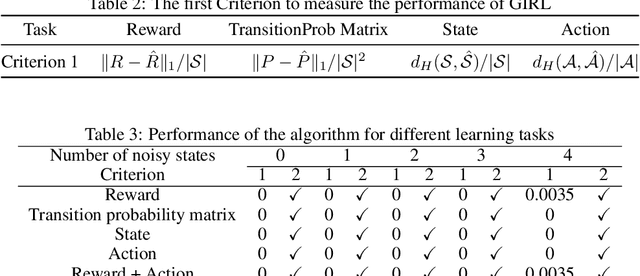
Abstract:This paper studies generalized inverse reinforcement learning (GIRL) in Markov decision processes (MDPs), that is, the problem of learning the basic components of an MDP given observed behavior (policy) that might not be optimal. These components include not only the reward function and transition probability matrices, but also the action space and state space that are not exactly known but are known to belong to given uncertainty sets. We address two key challenges in GIRL: first, the need to quantify the discrepancy between the observed policy and the underlying optimal policy; second, the difficulty of mathematically characterizing the underlying optimal policy when the basic components of an MDP are unobservable or partially observable. Then, we propose the mathematical formulation for GIRL and develop a fast heuristic algorithm. Numerical results on both finite and infinite state problems show the merit of our formulation and algorithm.
qecGPT: decoding Quantum Error-correcting Codes with Generative Pre-trained Transformers
Jul 18, 2023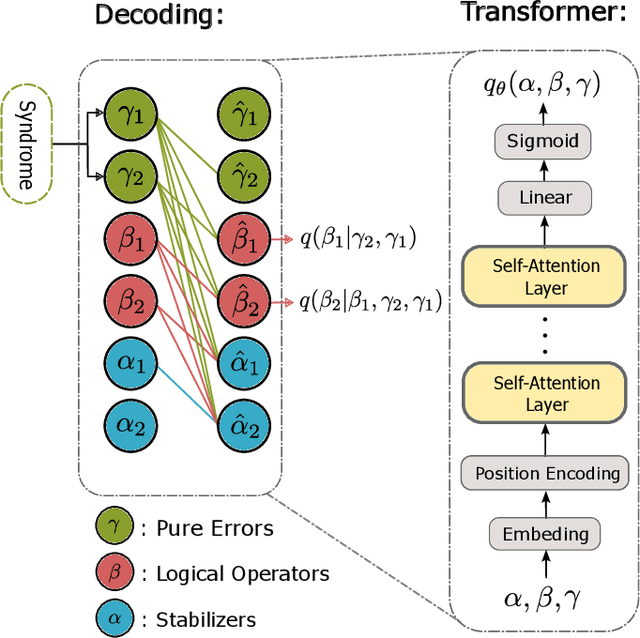

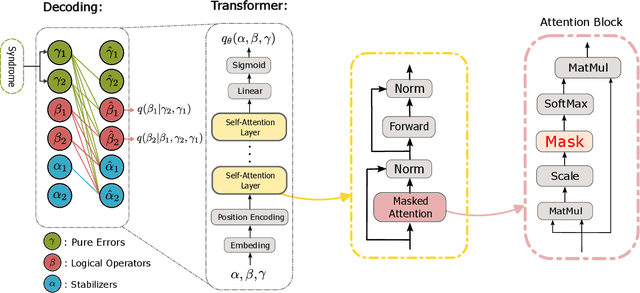

Abstract:We propose a general framework for decoding quantum error-correcting codes with generative modeling. The model utilizes autoregressive neural networks, specifically Transformers, to learn the joint probability of logical operators and syndromes. This training is in an unsupervised way, without the need for labeled training data, and is thus referred to as pre-training. After the pre-training, the model can efficiently compute the likelihood of logical operators for any given syndrome, using maximum likelihood decoding. It can directly generate the most-likely logical operators with computational complexity $\mathcal O(2k)$ in the number of logical qubits $k$, which is significantly better than the conventional maximum likelihood decoding algorithms that require $\mathcal O(4^k)$ computation. Based on the pre-trained model, we further propose refinement to achieve more accurately the likelihood of logical operators for a given syndrome by directly sampling the stabilizer operators. We perform numerical experiments on stabilizer codes with small code distances, using both depolarizing error models and error models with correlated noise. The results show that our approach provides significantly better decoding accuracy than the minimum weight perfect matching and belief-propagation-based algorithms. Our framework is general and can be applied to any error model and quantum codes with different topologies such as surface codes and quantum LDPC codes. Furthermore, it leverages the parallelization capabilities of GPUs, enabling simultaneous decoding of a large number of syndromes. Our approach sheds light on the efficient and accurate decoding of quantum error-correcting codes using generative artificial intelligence and modern computational power.
Prediction of single well production rate in water-flooding oil fields driven by the fusion of static, temporal and spatial information
Feb 22, 2023Abstract:It is very difficult to forecast the production rate of oil wells as the output of a single well is sensitive to various uncertain factors, which implicitly or explicitly show the influence of the static, temporal and spatial properties on the oil well production. In this study, a novel machine learning model is constructed to fuse the static geological information, dynamic well production history, and spatial information of the adjacent water injection wells. There are 3 basic modules in this stacking model, which are regarded as the encoders to extract the features from different types of data. One is Multi-Layer Perceptron, which is to analyze the static geological properties of the reservoir that might influence the well production rate. The other two are both LSTMs, which have the input in the form of two matrices rather than vectors, standing for the temporal and the spatial information of the target well. The difference of the two modules is that in the spatial information processing module we take into consideration the time delay of water flooding response, from the injection well to the target well. In addition, we use Symbolic Transfer Entropy to prove the superiorities of the stacking model from the perspective of Causality Discovery. It is proved theoretically and practically that the presented model can make full use of the model structure to integrate the characteristics of the data and the experts' knowledge into the process of machine learning, greatly improving the accuracy and generalization ability of prediction.
Faster Approximate Dynamic Programming by Freezing Slow States
Jan 03, 2023



Abstract:We consider infinite horizon Markov decision processes (MDPs) with fast-slow structure, meaning that certain parts of the state space move "fast" (and in a sense, are more influential) while other parts transition more "slowly." Such structure is common in real-world problems where sequential decisions need to be made at high frequencies, yet information that varies at a slower timescale also influences the optimal policy. Examples include: (1) service allocation for a multi-class queue with (slowly varying) stochastic costs, (2) a restless multi-armed bandit with an environmental state, and (3) energy demand response, where both day-ahead and real-time prices play a role in the firm's revenue. Models that fully capture these problems often result in MDPs with large state spaces and large effective time horizons (due to frequent decisions), rendering them computationally intractable. We propose an approximate dynamic programming algorithmic framework based on the idea of "freezing" the slow states, solving a set of simpler finite-horizon MDPs (the lower-level MDPs), and applying value iteration (VI) to an auxiliary MDP that transitions on a slower timescale (the upper-level MDP). We also extend the technique to a function approximation setting, where a feature-based linear architecture is used. On the theoretical side, we analyze the regret incurred by each variant of our frozen-state approach. Finally, we give empirical evidence that the frozen-state approach generates effective policies using just a fraction of the computational cost, while illustrating that simply omitting slow states from the decision modeling is often not a viable heuristic.
 Add to Chrome
Add to Chrome Add to Firefox
Add to Firefox Add to Edge
Add to Edge